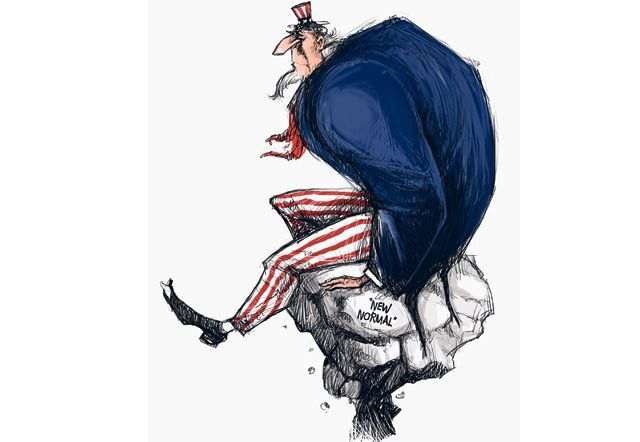A disquieting phrase has entered our economic lexicon: "new normal". The "new normal" economy that emerges from our recovery, many economists fear, won't look like the old normal, the American economy of the past couple of decades. It will look worse.
This is not, after all, a normal recession but a recession prompted by a banking meltdown. To gauge what that means for a recovery, consider the conclusions of a recent International Monetary Fund report that looked at 88 banking crises around the world over the past four decades. It found, on average, that seven years after these crises, the economic output of the affected nations was still 10 per cent below what it would have been had the crisis not happened.
In this crisis, of course, vastly more wealth has been destroyed than in a normal downturn. The chief activity of American consumers for the next half-decade at least will be paying down debt. In consequence, a growing number of economists and financiers believe that our nearly 10 per cent unemployment rate isn't simply a lagging indicator of the recession but, rather, betokens a long period of economic weakness in which our normal unemployment rate won't be the 4 or 5 per cent to which we've been accustomed but more like 7 per cent — high enough to depress wage levels across the broader economy.
Bloomberg News noted this week that Mohammad Al Erian, chief executive of Pacific Investment Management, which handles the world's largest bond fund, foresees an annual post-recession US growth rate of about 2 per cent, down from the 2.8 per cent rate the nation experienced between the end of the dot-com bust and the start of the housing-banking bust. When you consider that US median household incomes did not rise during that period of 2.8 per cent growth, the economic prospects for Americans after this recession ends look mighty glum.
Unemployment
Gloomiest of all is the prospect of steady high unemployment. By the standards of every postwar recession, today's unemployment rate is several points higher than it should be. The share of unemployed and underemployed Americans hovers around 17 per cent and would be higher still if millions of Americans had not dropped out of the labour force altogether.
Perhaps most troubling, it's hard to foresee where the next wave of American prosperity will come from. Manufacturing now employs just one in 10 American workers; the vast majority of new jobs in recent decades has come in the service and retail sectors, which tend not to be as productive and don't pay as well. Our two most recent bouts with prosperity were the result not of productive enterprise but of asset bubbles, first in dot-com stocks, then in housing.
So are we to be stuck with enduring high unemployment and the across-the-board income stagnation that accompanies it? Is that our "new normal"? Only if we believe that we are condemned to a cycle of underinvestment in and underconsumption by the American people.
But there's a way to break that cycle: public investment. We need to augment our current stimulus programme with further federal investments that restore and build transportation projects and that professionalise and enlarge our child-care and senior-care sectors. We need to do more to bolster "green" construction and manufacturing, and to ensure that such federally backed manufacturing takes place in the United States.
The all-but-universal wisdom, of course, is that the Obama administration does not dare ask Congress for an additional stimulus package. There are politically safer expedients that are surely necessary as well: An extension of unemployment benefits and Cobra health coverage, job-creation tax credits for businesses, perhaps even a partial suspension of the payroll tax. But none of these would frontally address the problem of persistent high unemployment.
But is a new federal public works program really that unsalable? Consider the experience of Perry County, Tennessee, where the closing of an auto parts factory had increased unemployment to a staggering 27 per cent this spring. Tennessee Governor Phil Bredesen, a Democrat, decided to use federal stimulus funds to immediately subsidise hundreds of new jobs — some public, some private — which reduced the local unemployment rate five percentage points by June. "If I could have done a WPA out there," Bredesen told The New York Times' Michael Cooper in July, referring to the New Deal's largest job-creation programme, "I would have done a WPA out there."
Tennessee is not, by most accounts, a sleeper cell of socialists, yet its reversion to New Deal economics has been met with approval from residents. It's too small, though, to do its own Work Projects Administration. Only the federal government can do that — and it should.
- Harold Meyerson is editor-at-large of American Prospect and the LA Weekly.













